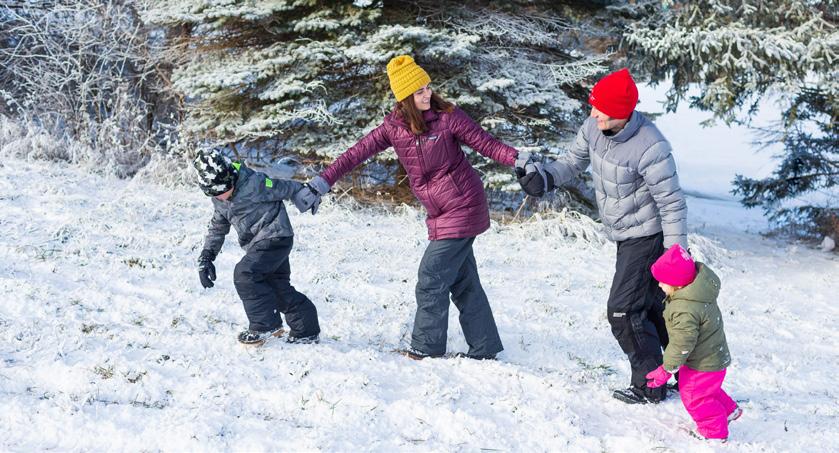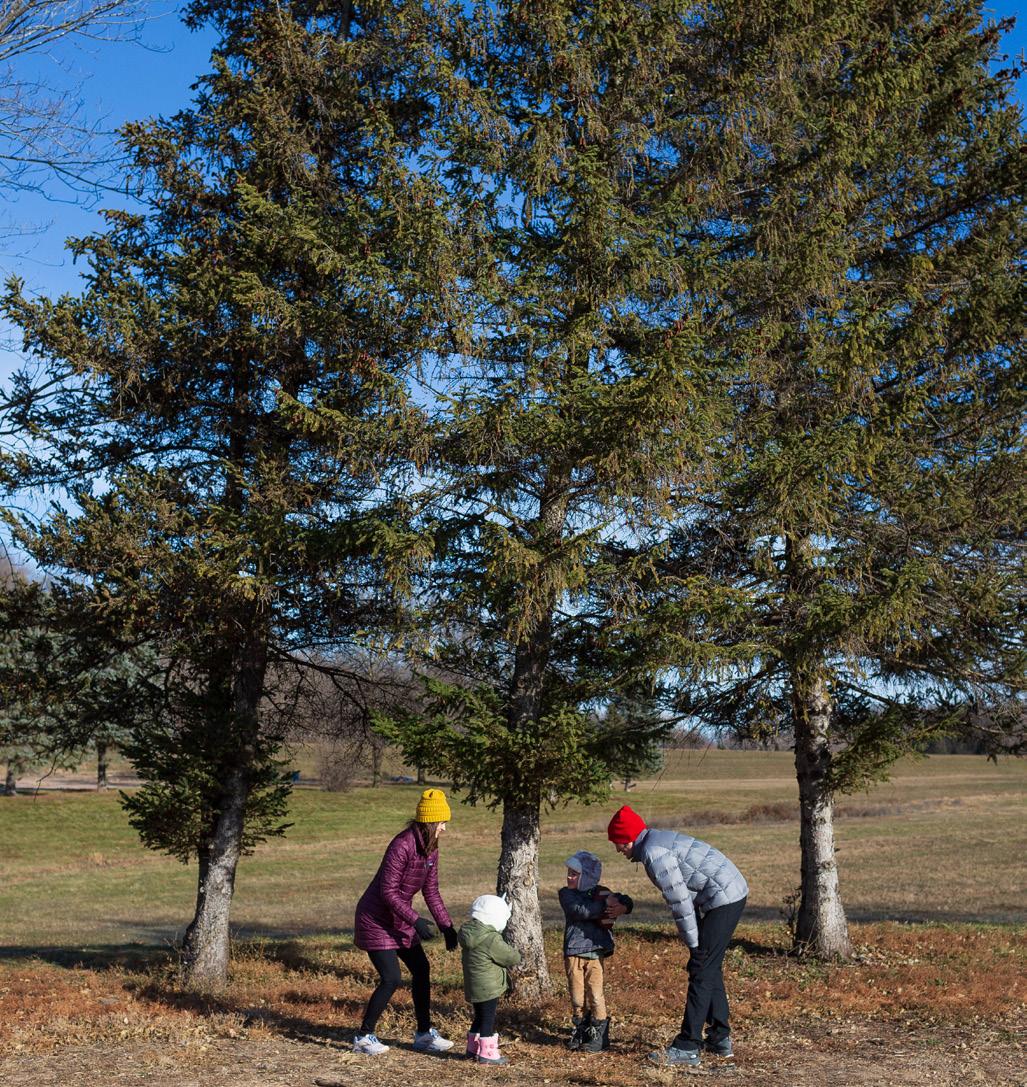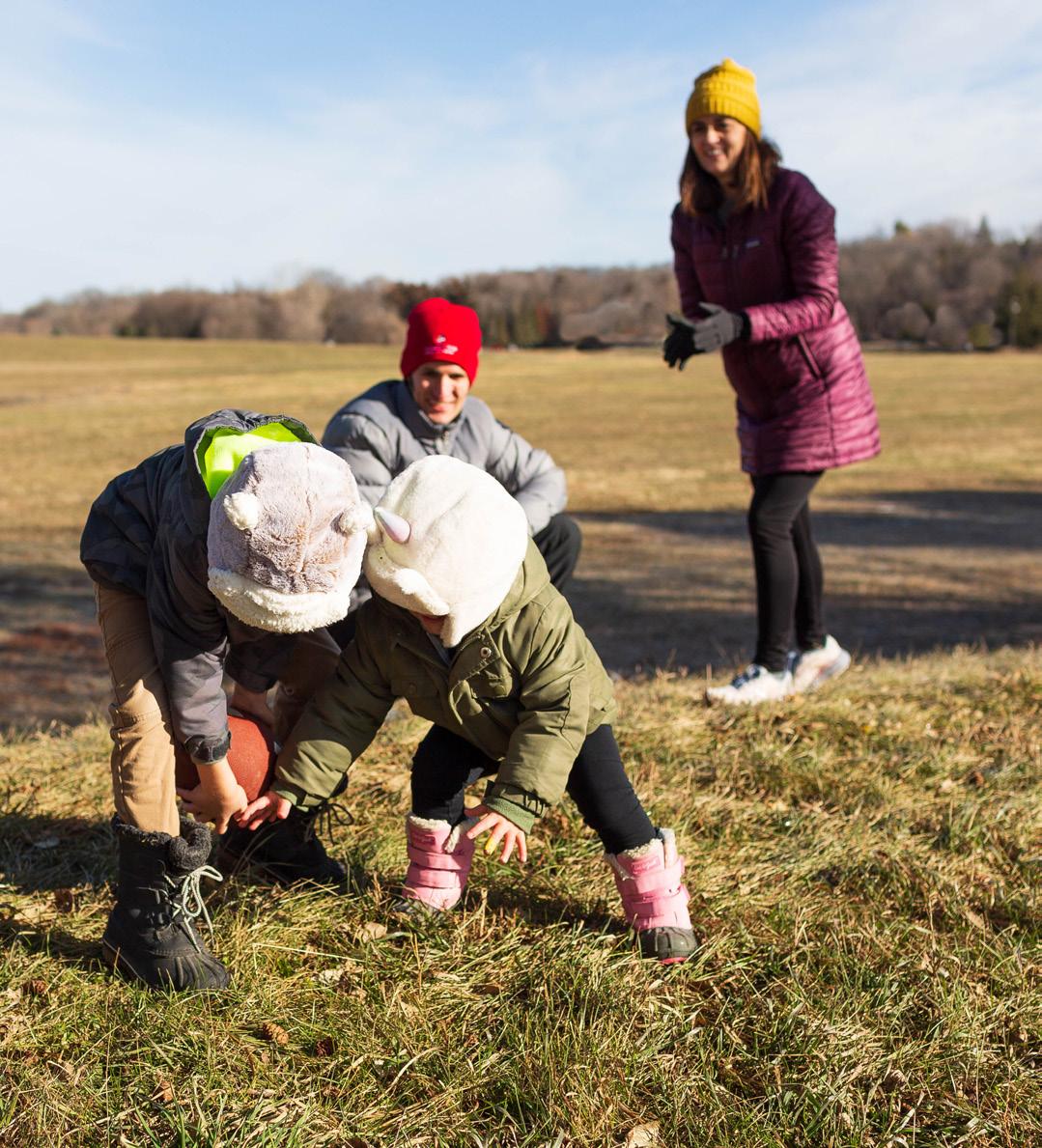
6 minute read
Getting Outside is Good for Us
Getting Outside is Good for Us
By Kendra Finn, DO, Mankato Clinic Family Medicine
Photos by Michelle Isebrand Photography
OUTDOOR EXERCISE HAS ALSO SHOWN TO BE A BETTER MOOD BOOSTER THAN INDOOR EXERCISE.
With two young children, our family likes to go outside and play in the snow. We usually build snow forts because my husband is an expert! While sledding is fun too, our kiddos aren’t quite ready for Mankato’s bigger hills yet.


Playing, moving and being outside brings joy and health perks for people of all ages. Let’s look at the ways we all benefit from outside time!
Physical Health
We tend to play, exercise and expend more energy outside versus inside. Physical activity is key to building strong muscles and bones and helping us maintain our weight. Exercise and fresh air also improve our sleep quality –making it easier to fall asleep and stay asleep. Being active outdoors can be as simple as a short walk or throwing a football with the kids.
Mental Health
Getting outside in the natural daylight can lift our mood and improve our cognitive function. Studies show that a 15-minute walk outside can boost executive function, which is a set of mental skills that help us stay focused, follow directions, plan and meet goals. That’s why a walk around the block can clear your head!
Outdoor exercise has also shown to be a better mood booster than indoor exercise. In fact, 30 minutes of outdoor exercise can be as beneficial as an antidepressant for mild depression.
If you have limited mobility or health issues that keep you from going outside in the winter, enjoy the natural daylight by opening drapes and blinds to bring the outdoors in.
Vitamin D
Did you know sunlight triggers the body to create vitamin D? And vitamin D helps your body absorb more calcium which is essential for bone health and muscle and nerve functions. Vitamin D also helps the body’s immune system to fight off bacteria and viruses. I believe that most of us who live in this region are vitamin D deficient and could benefit from a vitamin D supplement in the winter months. Talk to your primary care provider about the right supplement for you.
Growth & Development for Kiddos
Our natural world gives young children many ways to learn and develop. When children head outdoors in the winter, they learn to get around in different environments like snow, ice and uneven terrain. This is important for developing balance and gross motor skills.

Playing outside also helps children regulate their behavior. The American Academy of Pediatrics reports that children who spend time in natural settings have less anger and aggression and can better control their impulses.
We also know that playing outside promotes curious and creative thinking. There are lots of problems to solve outside! Watch a child figure out the easiest way up a sledding hill or how to get snow to stick together for a snowman. Studies show that children who spend more time in nature have improved learning outcomes.
So, let’s get outdoors! And when it’s time to come in, snuggle up with a cup of tea or cocoa!

Safety Tips
• Be careful when it’s icy. Watch for slippery spots and avoid them. Wear shoes or boots with good traction.
• Dress for the weather: coat, hat, mittens, boots. Since outerwear can be expensive, shop thrift stores, accept hand-me-downs and seek help from local organizations such as the Salvation Army’s Bundle Me Warm program.
• Watch the weather. Extremely low temperatures and high winds call for caution. Stay indoors during severe winter weather.
Embrace Outdoor Sports & Activities
By Thomas Finn, DO, Mankato Clinic Sports Medicine
Photos by Michelle Isebrand Photography
Being physically active helps us feel good, sleep better, lifts our mood, reduces anxiety and lowers blood pressure. Long-term, physical activity can boost brain, heart and bone health.

When we head outdoors to work out, health benefits snowball! In fact, studies show that physical activity outdoors lowers the body’s blood pressure and heart rate.
Walking, running, hiking, cross-country and downhill skiing, ice skating, and snowshoeing are good options for outdoor sports and activities. When we do aerobic activities in cold weather, we burn extra calories to stay warm.
Best of all, exercise and sunlight team up to boost our mood and prevent winter blues. When we exercise outside, the body releases more “feel good” chemicals such as serotonin, endorphins and dopamine. Serotonin helps us feel happy and calm. Endorphins target pain and stress relief. Dopamine gives us a sense of pleasure.

To exercise safely and prevent injury, follow these tips.
Warm-up: A warm-up, such as a slower or lower-intensity version of the planned exercise, helps get your body ready for more intense exercise by activating and loosening up your muscles and priming your central nervous system. It should take 5-10 minutes. Additionally, a 5–10 minute postexercise cool-down can help with recovery and prevent the feeling of lightheadedness some people get when they stop exercise too quickly.
Not everyone needs a dedicated period of stretching, but it can be important in helping regain or maintain full functional motion. If you do stretch, it's usually best to do this after the muscles are already warmed up or at the end of the workout.
Drink water before, during and after workouts. When it’s cold, our thirst and urge to drink water decreases. So be sure to drink water throughout your day.
Dress in layers: The base layer closest to your skin should be a thin, moisturewicking material like polyester or polypropylene. Over your base layer, add an insulating layer such as polyester fleece or wool. The third layer should be a jacket or shell to block the wind or snow.
Head, Hands, Feet: Ears, nose, fingers and toes are vulnerable to frostbite. Wear a hat, gloves or mittens, and warm socks. In colder weather, you may also need a face mask, gator or goggles. To keep feet warm and dry, wear proper footwear or boots that have good traction to prevent slips and falls.
Be weather aware: During winter storm, blizzard and cold weather warnings and advisories, take your workouts indoors. Use common sense when temperatures and wind chills are low.
Watch for signs of frostbite and hypothermia (low body temperature). If you feel tingling or numbness or notice redness or pain in your fingers, toes, ears or nose, get inside and warm up. These are early warning signs of frostbite. Signs and symptoms of hypothermia are shivering, fatigue, confusion, slurred speech and memory loss. Seek medical help right away.
Talk with your primary care provider before beginning a new exercise routine or sport.


